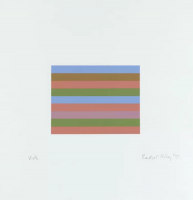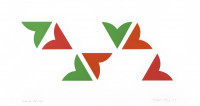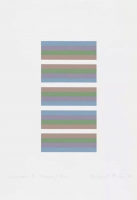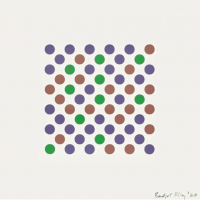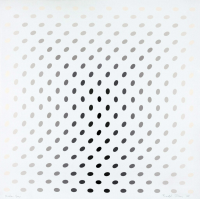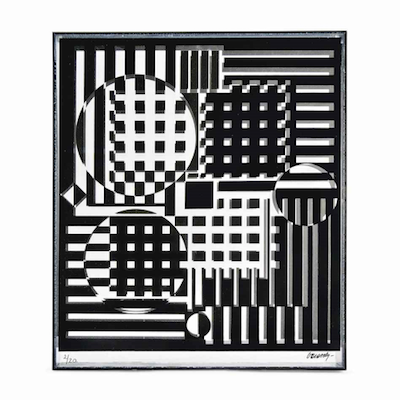
Details
Artist
Styles
Colour screenprint on white wove paper - Signed, numbered and dated on the front // Bridget Riley's Print for Chicago 8, created in 1971, is a limited edition screen-print that exemplifies her mastery of optical art. The artwork, measuring 61 x 46 cm, features a series of vertical lines in alternating colors, including yellow, purple, teal, and orange. The lines are slightly wavy, creating an undulating rhythm that draws the viewer’s eye along the length of the piece, causing an optical illusion of movement and vibration. Riley’s precise use of color and form manipulates perception, evoking a sense of depth and dynamism within a seemingly simple geometric structure. This print is a powerful example of how she uses color and pattern to engage the viewer in a visual experience that is both captivating and disorienting.
Print for Chicago 8, 1971
form
Medium
Size
61 x 46 cm
- Inches
- Centimeters
Edition
Range
- USD
- EUR
- GBP
Details
Artist
Styles
Colour screenprint on white wove paper - Signed, numbered and dated on the front // Bridget Riley's Print for Chicago 8, created in 1971, is a limited edition screen-print that exemplifies her mastery of optical art. The artwork, measuring 61 x 46 cm, features a series of vertical lines in alternating colors, including yellow, purple, teal, and orange. The lines are slightly wavy, creating an undulating rhythm that draws the viewer’s eye along the length of the piece, causing an optical illusion of movement and vibration. Riley’s precise use of color and form manipulates perception, evoking a sense of depth and dynamism within a seemingly simple geometric structure. This print is a powerful example of how she uses color and pattern to engage the viewer in a visual experience that is both captivating and disorienting.
- Recently Added
- Price (low-high )
- Price (high-low )
- Year (low-high )
- Year (high-low )
Bridget Riley
Intervals 3 - Orange / Blue, 2021
Limited Edition Print
Screen-print
Inquire For Price
Bridget Riley
Intervals 3 (Green/Purple), 2021
Limited Edition Print
Screen-print
GBP 7,000 - 10,000
What is Op Art?
Op Art is a visual art style that uses optical illusions to create the impression of movement, vibrating patterns, flashing, or hidden images. The works are typically abstract, with many well-known pieces in black and white. The roots of Op Art can be traced back to earlier movements like Futurism, Constructivism, Dada, and Neo-Impressionism, particularly in their use of color effects and graphic design.


